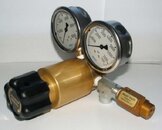I am not an expert by any means so don't take my word for anything, but here is my take on it:
I don't see a need for the third gauge after the O2 reg. There shouldn't hardly be any pressure there. Dial the second gauge to around 32 psi when the compressor is producing 32% and then remove the needle valve knob and set pressure by the regulator. The regulator will require minor adjusting as the bank pressures get higher.
Instead of using all those fancy digital pressure gauges, spend the money on a nice regulator with a couple gauges for filling tanks. Much nicer to start your fills and be able to walk away knowing you are not going to put 4,500 psi in your AL 80 or even HP tanks. If it were me, I would get rid of the panel, the three valves, and the two gauges, and go with the simple system shown below. Maybe with a little lower pressure gauges then what is shown below though. I also don't see a need for the relief valve since our tanks have burst disks. Better yet, just don't crank the pressure up too high.

Not sure if your compressor has a gauge on it or not, but I like knowing what my pressure is before the filter stack. Especially when the auto drains kick in.
I assume the OPV valve after the filters is a valve to maintain over 2,500 psi in the filter stacks? Pressure is what allows the filters to work.
Personally I like to occasionally see my actual O2 output under pressure to confirm my inputs and outputs are around the same. A flow meter for the CO monitor and the O2 monitor would be in order. I would also just run them off the same port, and only monitor downstream O2 occasionally (You will be running your compressor for hours at a time). My preference if I was blending Trimix, would be for a downstream Trimix analyzer.
If you are seeing a weird reading on the O2 sensors before the compressor you may have a little bit of vacuum due to a restriction. Does it change depending on whether the compressor is on or off? I would think 2 O2 monitors at the stick would be preferable, so you can continuously monitor HE (Well not directly, but you know what I mean) and O2 content without switching things around. (If the meter shown has dual displays then not an issue).
There shouldn't be a check valve at the banks, as what flows in needs to flow out. Personally I don't have an over pressure valve anywhere but at the compressor, and only in case the auto shutoff mechanism fails.
Your gonna need more bank bottles around say 3-4 3,500 psi banks. You will quickly kill those 4,500 psi banks for topping off by filling tanks up from 700 psi. I cascade every bank bottle independently and do so by just turning the valves on each of the bank bottles themselves. My system is about as simple as it can be.
Also more fills whips! I have four and sometimes wish I had five.
Probably the biggest thing I don't see is a way to shut the O2 off when the compressor shuts off. You need a solenoid mounted on the O2 output somewhere before the mixing stick, or mounted on the mixing stick. If the compressor shuts off then restarts it could go BOOM!





